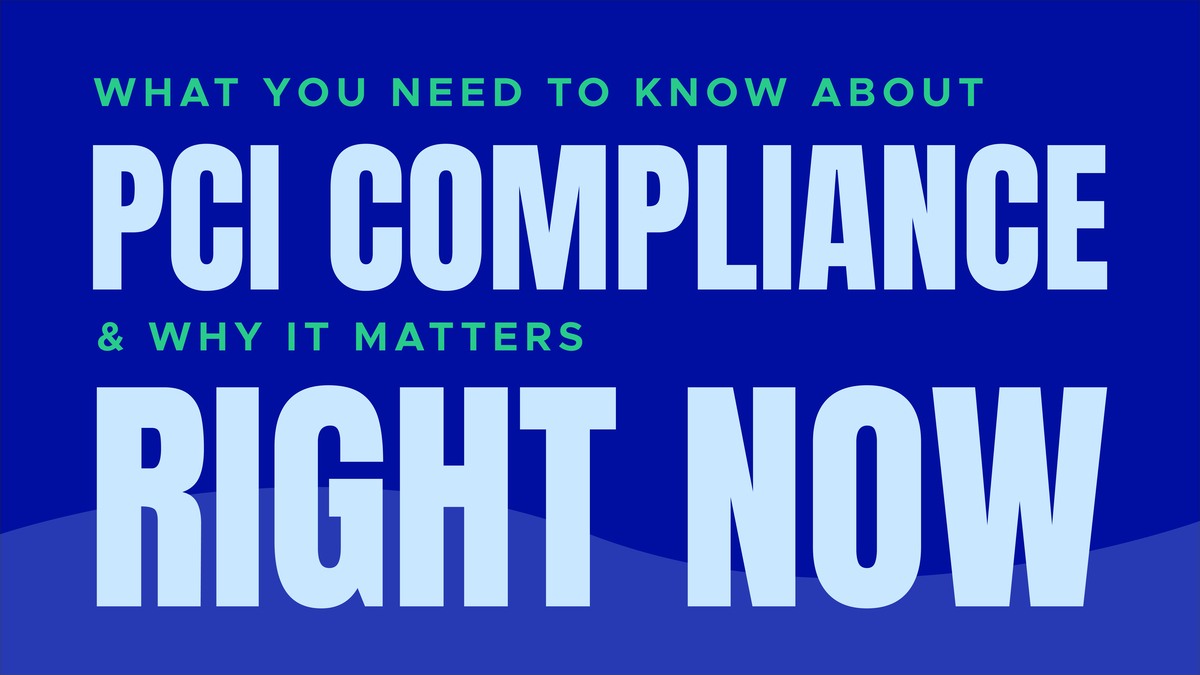blog
What You Need to Know About PCI Compliance and Why It Matters Right Now

When you’re juggling countless business responsibilities, does payment security end up on the back burner? You might trust that your payment processor or web developer handled it, yet still question if every requirement has been met.
PCI compliance comes with technical language, detailed checklists, and constant updates that can overwhelm even the most organized teams. Without clear ownership or regular checks, you may overlook gaps. Missing even one requirement can trigger penalties, open the door to security risks, and erode customer trust.
PCI compliance safeguards your business, protects your customers, and reinforces the credibility you’ve worked hard to build. By knowing where you stand and fixing any gaps, you can operate with confidence.
This article shows you what PCI compliance involves and why delaying action could put your business and customers at immediate risk.
Why PCI Compliance Should Be a Priority for Your Business
You can’t strengthen PCI compliance until you understand the impact it has on your business. The consequences of overlooking it can directly impact your ability to operate with customer trust.
Real Risks of Ignoring PCI Standards
When a business ignores PCI compliance, the risks extend far beyond technical issues. Data breaches that expose customer credit card information can result in costly investigations, mandatory customer notifications, and ongoing monitoring expenses.
Regulatory fines for non-compliance can be substantial, often running into thousands of dollars. Beyond the financial impact, a single incident can damage your brand’s reputation and lead to a loss of customer trust that takes years to rebuild.
Misconceptions That Put PCI Compliance at Risk
Understanding the stakes also means addressing common myths that create a false sense of security. Many businesses believe their payment processor handles PCI compliance entirely. While processors have their own requirements, you still have responsibilities for your website and payment environment.
Some assume small websites are safe from targeting, but attackers often look for smaller businesses with weaker defenses. Another common belief is that SSL encryption alone provides coverage. SSL is one important element, but it does not replace the broader safeguards required under PCI standards.

Hidden PCI Compliance Gaps Businesses Often Miss
Even businesses that understand the importance of PCI compliance can fall short when it comes to implementation. These gaps often happen quietly and can go unnoticed until they cause a problem.
Who Holds PCI Compliance Responsibility
PCI compliance is a shared responsibility. Web developers may build secure sites, and payment processors may handle card transactions, but the business owner is ultimately accountable. Assuming someone else is managing it can leave gaps that create costly problems later.
Website Security Weak Points That Jeopardize Compliance
Responsibility is only part of the problem. Technical vulnerabilities also compromise compliance. Outdated plugins, themes, and platforms create security openings hackers exploit.
Checkout processes that fail to meet PCI guidelines put your business and your customers at risk. Another often-missed issue is unclear data flow. You need to know exactly where cardholder data travels, where it is stored, and whether you are even supposed to see it.

Simple Actions to Strengthen PCI Compliance
Closing compliance gaps does not have to feel overwhelming. Breaking the process into manageable steps makes it easier to maintain ongoing protection.
Audit Your Payment Process
Start by mapping the entire customer payment journey on your website. Identify every point where cardholder data is transmitted or stored. This step alone can reveal risks you may not realize exist.
Work with a PCI-Compliant Payment Processor
Once you understand your payment flow, choose a processor that meets current PCI standards. Avoid storing any credit card data on your website or in admin areas.
Keep Website Security Practices Current
A secure payment process depends on a secure website. Update plugins, themes, and CMS platforms regularly. Require SSL encryption across all pages, not just at checkout. Use strong password policies and limit admin access to essential team members.
Run Regular Compliance Scans and Reviews
Routine checks help you stay compliant. Run automated PCI compliance scans to detect vulnerabilities. Keep a checklist of ongoing compliance tasks so nothing slips through the cracks.
Expert PCI Compliance Tips for Smoother Management
Once you’ve addressed the fundamentals, you can go further by streamlining how you manage compliance. The following expert tips help reduce mistakes, simplify oversight, and keep your payment security strong year-round.
- Understand How Cardholder Data Moves
It’s not just about what shows on the checkout page. You need to understand where that data goes, where it touches, and whether you are even supposed to see it. Spoiler: you usually aren’t. - Remove Access to Card Data You Shouldn’t See
Are you emailing customers invoices with card numbers on them? Writing it down? Don't. It’s like leaving sensitive data exposed in your site’s backend. You should never be able to see full card details. If you can, something is already wrong. - Keep Plugins and Platforms Fully Updated
Old plugins can destroy your compliance quickly. You might be forced to choose between keeping your plugin or upgrading to a compliant server setup. PCI will win that fight every time. Stay ahead of it. - Assign a Dedicated PCI Compliance Owner
This lives in the overlap between dev, legal, and IT. Someone in your business should own PCI compliance or at least know enough to call in the right help when needed. - Test Changes in a Secure Sandbox
Always test changes in a sandbox before going live, especially checkout updates. You might accidentally trigger a shift from SAQ A (minimal requirements) to SAQ A-EP (more complex) with a simple mistake. If you miss it, you’re responsible. - Choose Verified PCI Compliance Tools
Tools like SecurityMetrics often come bundled with processors, but they push hard to upsell and lean on broad definitions to justify more services. Some non-certified tools can help spot issues but won’t count if you get audited. Stick to tools listed by PCI SSC or used by pros during formal audits.

How Proactive PCI Compliance Benefits Your Business
Strong PCI compliance delivers benefits beyond avoiding penalties. It positions your business as one that values customer security and takes preventive action seriously.
Reduce Fines and Prevent Data Breaches
Detecting risks early and taking proactive steps reduces the likelihood of breaches and penalties. Protecting sensitive customer information builds confidence and strengthens long-term loyalty.
Make PCI Compliance a Shared Team Effort
Long-term compliance works best when the responsibility does not rest on one person. Educate your team on best practices and create clear processes for ongoing website security. Assign responsibilities to keep compliance consistent year-round.
Strengthen PCI Compliance with Legend
Legend helps businesses identify and close PCI compliance gaps before they turn into costly problems.
Our team reviews your current payment process, evaluates security measures, and implements strategies that align with PCI requirements. We make it easier to understand what needs to be done and how to maintain compliance over time.
Protect your business, your customers, and your reputation. Talk to Legend today about building stronger PCI compliance into your operations.

